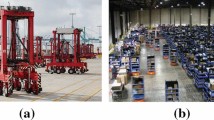Abstract
We present Guaranteed Search with Spanning Trees (GSST), an anytime algorithm for multi-robot search. The problem is as follows: clear the environment of any adversarial target using the fewest number of searchers. This problem is NP-hard on arbitrary graphs but can be solved in linear-time on trees. Our algorithm generates spanning trees of a graphical representation of the environment to guide the search. At any time, spanning tree generation can be stopped yielding the best strategy so far. The resulting strategy can be modified online if additional information becomes available. Though GSST does not have performance guarantees after its first iteration, we prove that several variations will find an optimal solution given sufficient runtime. We test GSST in simulation and on a human-robot search team using a distributed implementation. GSST quickly generates clearing schedules with as few as 50% of the searchers used by competing algorithms.
Similar content being viewed by others
References
Alspach, B. (2006). Searching and sweeping graphs: a brief survey. Matematiche, 59, 5–37.
Barrière, L., Flocchini, P., Fraigniaud, P., & Santoro, N. (2002). Capture of an intruder by mobile agents. In Proc. 14th ACM symp. parallel algorithms and architectures (pp. 200–209).
Barrière, L., Fraigniaud, P., Santoro, N., & Thilikos, D. (2003). Searching is not jumping. Graph-Theoretic Concepts in Computer Science, 2880, 34–45.
Bienstock, D., & Seymour, P. (1991). Monotonicity in graph searching. Journal of Algorithms, 12(2), 239–245.
Char, J. (1968). Generation of trees, two-trees, and storage of master forests. IEEE Transactions on Circuit Theory, 15(3), 228–238.
Dendris, N., Kirousis, L., & Thilikos, D. (1994). Fugitive-search games on graphs and related parameters. In Proc. 20th int. workshop graph-theoretic concepts in computer science (pp. 331–342).
Flocchini, P., Nayak, A., & Schulz, A. (2005). Cleaning an arbitrary regular network with mobile agents. In Proc. int. conf. distributed computing and Internet technology (pp. 132–142).
Flocchini, P., Huang, M., & Luccio, F. (2007). Decontamination of chordal rings and tori using mobile agents. International Journal of Foundations of Computer Science, 18(3), 547–564.
Flocchini, P., Huang, M., & Luccio, F. (2008). Decontamination of hypercubes by mobile agents. Networks, 52(3), 167–178.
Fomin, F., & Thilikos, D. (2008). An annotated bibliography on guaranteed graph searching. Theoretical Computer Science, 399, 236–245.
Fomin, F., Fraigniaud, P., & Thilikos, D. (2004). The price of connectedness in expansions. Technical Report LSI-04-28-R, UPC Barcelona.
Fraigniaud, P., & Nisse, N. (2006). Connected treewidth and connected graph searching. In Proc. 7th Latin American symp. theoretical informatics.
Gerkey, B. (2004). Pursuit-evasion with teams of robots. http://ai.stanford.edu/~gerkey/research/pe/index.html.
Gerkey, B., Vaughan, R., & Howard, A. (2003). The player/stage project: tools for multi-robot and distributed sensor systems. In Proc. int. conf. advanced robotics (pp. 317–323).
Gerkey, B., Thrun, S., & Gordon, G. (2005). Parallel stochastic hill-climbing with small teams. In Proc. 3rd int. NRL workshop multi-robot systems.
Guibas, L., Latombe, J., LaValle, S., Lin, D., & Motwani, R. (1999). Visibility-based pursuit-evasion in a polygonal environment. International Journal of Computational Geometry and Applications, 9(5), 471–494.
Hollinger, G., Kehagias, A., & Singh, S. (2009a). Efficient, guaranteed search with multi-agent teams. In Proc. robotics: science and systems conf.
Hollinger, G., Singh, S., Djugash, J., & Kehagias, A. (2009b). Efficient multi-robot search for a moving target. International Journal of Robotics Research, 28(2), 201–219.
Isler, V., Kannan, S., & Khanna, S. (2005). Randomized pursuit-evasion in a polygonal environment. IEEE Transactions on Robotics, 21(5), 875–884.
Kalra, N. (2006). A market-based framework for tightly-coupled planned coordination in multirobot teams. Ph.D. thesis, Robotics Institute, Carnegie Mellon Univ.
Kehagias, A., Hollinger, G., & Gelastopoulos, A. (2009a). Searching the nodes of a graph: theory and algorithms. Technical Report arXiv:0905.3359 [cs.DM].
Kehagias, A., Hollinger, G., & Singh, S. (2009b). A graph search algorithm for indoor pursuit/evasion. Mathematical and Computer Modelling, 50(9–10), 1305–1317.
Kloks, T. (1994). Treewidth: computations and approximations. Berlin: Springer.
Kolling, A., & Carpin, S. (2008). Extracting surveillance graphs from robot maps. In Proc. int. conf. intelligent robots and systems.
Kolling, A., & Carpin, S. (2010). Pursuit-evasion on trees by robot teams. IEEE Transactions on Robotics, 26, 32–47.
Kumar, V., Rus, D., & Singh, S. (2004). Robot and sensor networks for first responders. Pervasive Computing, 3(4), 24–33.
LaPaugh, A. (1993). Recontamination does not help to search a graph. Journal of ACM, 40(2), 224–245.
LaValle, S. M. (2006). Planning algorithms. Cambridge: Cambridge University Press.
LaValle, S., Lin, D., Guibas, L., Latombe, J., & Motwani, R. (1997). Finding an unpredictable target in a workspace with obstacles. In Proc. IEEE international conf. robotics and automation.
Likhachev, M., Ferguson, D., Gordon, G., Stentz, A., & Thrun, S. (2005). Anytime dynamic A*: an anytime, replanning algorithm. In Proc. int. conf. automated planning and scheduling.
Megiddo, N., Hakimi, S., Garey, M., Johnson, D., & Papadimitriou, C. (1988). The complexity of searching a graph. Journal of ACM, 35(1), 18–44.
Parsons, T. (1976). Pursuit-evasion in a graph. In Y. Alavi, & D. Lick (Eds.) Theory and applications of graphs (pp. 426–441). Berlin: Springer.
Shewchuk, J. (2002). Delaunay refinement algorithms for triangular mesh generation. Computational Geometry: Theory and Applications, 22(1–3), 21–74.
Smith, T. (2007). Probabilistic planning for robotic exploration. Ph.D. thesis, Robotics Institute, Carnegie Mellon Univ.
Wilson, D. (1996). Generating random spanning trees more quickly than the cover time. In Proc. 28th ACM symp. theory of computing (pp. 296–303).
Yang, B., Dyer, D., & Alspach, B. (2004). Sweeping graphs with large clique number. In Proc. 5th international symp. algorithms and computation (pp. 908–920).
Zilberstein, S. (1996). Using anytime algorithms in intelligent systems. Artificial Intelligence Magazine, 17(3), 73–86.
Author information
Authors and Affiliations
Corresponding author
Electronic Supplementary Material
Below are the links to the electronic supplementary material.
(MP4 8,153 KB)
(MP4 5,321 KB)
Rights and permissions
About this article
Cite this article
Hollinger, G., Kehagias, A. & Singh, S. GSST: anytime guaranteed search. Auton Robot 29, 99–118 (2010). https://doi.org/10.1007/s10514-010-9189-9
Received:
Accepted:
Published:
Issue Date:
DOI: https://doi.org/10.1007/s10514-010-9189-9




